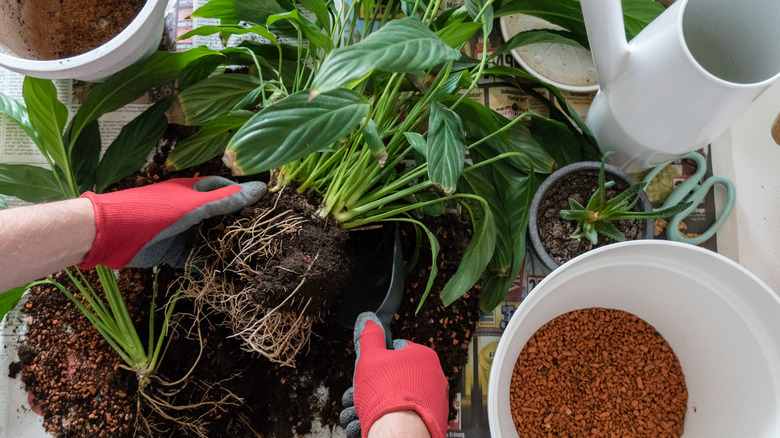The Best Way To Repot Peace Lily Plants To Keep The Lush Blooms Coming
We may receive a commission on purchases made from links.
Although you can't be completely hands-off, a peace lily (Spathiphyllum spp.) may be one of the easiest houseplants anyone can keep alive. As with most plants, peace lilies need to be repotted on an annual basis to make sure they continue thriving and producing the graceful, beautiful blooms that they are known for. However, there are a few things to remember to have optimal results when repotting. After your plant stops blooming in the spring is the best time to repot your peace lily. This will encourage the plant to put new energy from the nutrients in fresh soil into new growth, including a fresh batch of blooms.
Symptoms that indicate your peace lily is unhealthy and may need to be repotted include leaves that are yellow or brown, droopy, or wilted. Another obvious sign is when you see roots either growing out of the drainage holes or popping up above the topsoil. This means the plant is root-bound and should be repotted immediately.
Signs that may require more careful observation include stunted growth — when your plant rarely produces new leaves or flowers, and if they are, the new growth is small compared to what your peace lily previously grew. The soil's health also may require repotting. Your plant may be experiencing root rot, which calls for fresh soil and some root TLC, or overly compacted soil, which would require a new type of potting mix.
Steps to successfully repot a peace lily
Start with a planter that's just a few inches wider than the current pot. Peace lilies love soil that offers moisture and drainage, so choose something with peat moss or coco coir, like WONDER SOIL Organic Potting Soil. If you're using a standard potting mix, add perlite or vermiculite for aeration. Trim off dead flowers or older leaves to clean up your plant's appearance and help it direct energy toward new growth.
The actual repotting process is similar to how you'd repot any other plant, including loosening the root ball, possibly trimming your peace lily's roots, and gently tamping down the soil securely around the plant once it's in a new pot. Bury it at the same depth as it was in the original pot. This ensures the plant won't tip over because it's not planted deep enough and prevents it from sitting in wet soil.
After repotting, water the plant thoroughly to help it recover from any stress. After that, follow the best method for watering peace lilies and give it a drink when the top 2 inches of soil is dry. Keep the plant in a shadier spot than usual for the first week before moving it to a spot with indirect sunlight. For six weeks, hold off on fertilizing your plant. When it's ready, consider fertilizing your peace lily with common household items. Keep in mind that your plant may look wilted for a week or two after transplanting before it bounces back, so be patient.

